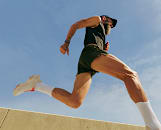
Can You Build Strength and Muscle with Light Weights and High Reps?
Experts explain how low-weight, high-rep workouts can fit into your strength routine.
By Tiffany Ayuda•
What Are Low-Weight, High-Rep Workouts?
Can You Build Strength and Muscle with Light Weights?
The Benefits of Low-Weight and High-Rep Workouts
5 Low-Weight, High-Rep Exercises to Try
How Low-Weight, High-Rep Workouts Can Fit Into Your Routine
You’re likely familiar with the benefits of lifting weights: gaining muscle, improving your strength, and even boosting confidence. But slamming down heavy barbells isn’t for everyone. You may prefer the pace and technique of lower intensity strength-training modalities that use light dumbbells, such as Pilates and barre. But can you reach your full strength potential with low-weight, high-rep workouts?
Discover more ways to reach your goals with Peloton
“‘Go hard or go home’ is a term many of us who regularly work out—whether at home, outside, or in the gym—have heard. When it comes to strength training, nine out of 10 times, this means lifting the heaviest weights you can in the gym,” says Peloton instructor Sam Yo. “But if you don’t want to go ‘full-on beast mode,’ using any load of weights to improve your strength can be beneficial compared to anyone who does nothing at all.”
There’s a place for light weights in your strength routine, but there are limits on how effective they can be for building major muscle power. Here, we break down what low-weight, high-rep training is, exactly, its benefits, and how to incorporate it into your workout routine to fit your personal goals.
What Are Low-Weight, High-Rep Workouts?
First, it helps to clarify what “counts” as a light or low weight. You’re typically completing a low-weight workout when you use a load below 67 percent of your one rep max (1RM), which is one rep of the heaviest weight you can lift for a given exercise, says Domenic Angelino, an exercise scientist and strength and conditioning coach. For example, if your 1RM for a biceps curl is 25 pounds, you may opt to use an 8-pound dumbbell for a low-weight, high-rep workout. Bodyweight exercises can also be included here, since they’re one way to do resistance training with lighter loads.
Next, we need to cover what would be considered high rep. Generally speaking, a high rep count is 12 or more reps per set, according to the strength-endurance continuum model, a training concept that describes how different rep ranges and loads affect your body’s response to workouts.

Peloton App
Access thousands of classes with no equipment needed.
Can You Build Strength and Muscle with Light Weights?
Relying on lighter weights and higher reps can help you build muscle and strength, especially if you’re new to exercise or strength training (thanks to something called “newbie gains”). However, your progress won’t be as rapid as it would be with heavier loads and fewer reps, Sam says.
In general, lifting heavier weights for low (1–6) reps builds maximal strength, lifting moderate weights for 8–12 reps builds muscle, and lifting lighter weights for high reps (12+) builds muscular endurance, according to the strength-endurance continuum.
“If someone were to recommend training to improve muscular endurance, they may recommend using a light weight for a larger number of reps, such as 12 to 20 reps,” Angelino says. Muscular endurance refers to your muscles’ ability to contract under force for an extended period of time. This differs from maximal strength, which is the maximal force a muscle can exert against resistance (think: lifting the heaviest weight possible).
So while it’s possible to build some muscle and strength with lighter weights and higher reps, it’s not the recommended approach, especially for people who are already strength training regularly. If you continue to complete your workouts with lighter weights, you’ll eventually reach a point of such slow adaptation that your progress is minimal, Angelino explains.
“Since the motor units you recruit with lighter weights are pretty small, it’ll feel like you hit a point where you’re not seeing much return on your investment [compared to] training with heavier weights,” he says. It happens with all training methods—there’s a limit to the gains you can make unless you meaningfully increase the challenge in some way. However, by working exclusively with lighter weights, you may plateau a bit sooner than if you opted for those heavier dumbbells, he says.

The Benefits of Low-Weight and High-Rep Workouts
1. They’re Safer.
Generally speaking, it’s easier to move lighter weights with control than heavier loads, which lowers your overall risk of injury, Sam says. Because light weights place less impact on your joints than heavy weights and you’re also more likely to maintain good form, it reduces the risk of stressing your ligaments or the tissue around your joints.
2. They Can Improve Your Muscular Endurance.
Low-weight, high-rep workouts build your muscular endurance by increasing the amount of time your muscles can contract under force. Your muscles don’t fatigue as quickly as they would with heavier loads, Sam says.
3. They Can Add a Cardio Element
You may be more likely to elevate your heart rate with lighter-weight workouts compared to heavy-weight ones. “Doing 12 or more repetitions per set not only benefits your muscular endurance but improves your cardiovascular fitness, due to the duration of an average set being longer than that with heavier weights,” Sam says.
4. They’re Perfect for Beginners.
If you’re a strength training novice, lifting lighter weights for more reps is a great approach. “It's extremely beneficial for beginners, building a strong foundation of strength, and encouraging consistency,” Sam says. You may find it easier to stick with lighter-weight strength workouts because the exercises may feel a bit more doable and leave you less sore. “Lifting lighter will also give you the benefit of better form, and the ability to develop a better mind-muscle connection with the muscle you’re using,” Sam says.

5 Low-Weight, High-Rep Exercises to Try
There’s really no limit to the exercises you can do with lighter weights and higher reps. Certain types of workouts, such as circuits and “as many rounds as possible” (AMRAP), are especially well-suited for light weights and high reps because they keep you moving without much rest time, Sam says.
Here are five specific moves you can try during your next low-weight, high-rep workout; try doing each for 3 sets of 12-15 reps.
1. Dumbbell Reverse Lunge
Stand with your feet hip-width apart. Hold a light dumbbell in each hand by your sides.
Take a big step back with your right leg. Bend both legs until each knee forms a 90-degree angle.
Hold for one second, then press through your left foot to stand up, and step your right foot back to the starting position.
Repeat on the other side.
2. Dumbbell Squat
Stand with your feet shoulder-width distance apart. Hold a light dumbbell in each hand by your sides.
Engage your core. Keeping your chest lifted, sit your hips back and bend your knees to lower your body into a squat. Pause when your thighs are about parallel to the ground.
Press your feet into the floor to stand up and return to the starting position.
3. Glute Bridge
Lie on your back with your arms by your sides. Bend your knees and place your feet flat on the ground, hip-width distance apart, so your heels are just past your fingertips. Grab a dumbbell and place it horizontally across your hips, holding it in place with both hands.
Engage your core and lift your hips until your body forms a straight diagonal line from your shoulders to your knees.
Hold at the top of the bridge for a breath. Slowly return to the starting position.
4. Dumbbell Biceps Curl
Stand with your feet hip-width distance apart. Hold a light dumbbell in each hand, palms facing forward.
Keeping your elbows close to your sides, curl the dumbbells up to your shoulders.
Hold for a second at the top, then slowly lower the weights back to the starting position.
5. Dumbbell Lateral Raise
Stand with your feet hip-width distance apart, knees slightly bent. Let your arms hang by your sides, a dumbbell in each hand, palms facing your body.
With your elbows slightly bent and core engaged, exhale and slowly lift the dumbbells out to the sides, leading with your elbows, until your arms are parallel to the ground, going no higher than shoulder height. Keep your shoulder blades back and down, away from your ears.
Lower the weights with control back to the starting position.
If you’d rather follow an instructor-led workout that uses low weights and high reps, try an Arms & Light Weights class or other strength class on the Peloton App.
How Low-Weight, High-Rep Workouts Can Fit Into Your Routine
Can your light weights replace your heavy dumbbells? The truth is, your strength routine—including how much weight you lift and the number of reps you do—should be tailored to your specific goals.
“It’s best to think of light-weight and heavy-weight training as being good at doing different things,” Angelino says. “Some programs warrant heavy-weight training. Some programs warrant light-weight training. Some programs warrant a mix of both. It’s very goal-dependent.”
If you’re aiming to increase your maximal strength, go for heavier weights and lower (1–6) reps. If you’d like to optimize muscle hypertrophy (aka muscle growth), lift moderate weights for a moderate number of reps (8–12) per set. To build muscular endurance, try lifting lighter weights for a higher number of reps (12+). And if you’re training for general health and longevity? It’s not a bad idea to include a mix of all three.
Whether you’re using light or heavy loads in your training, just remember to progress your workouts by increasing the weight by 5 to 10 percent every few weeks, Sam says. Using the same weights again and again will likely lead to a plateau. Your muscles need to be consistently challenged in order to continue to grow.
“If you’re hesitant to increase the weight, try practicing pause reps, adding resistance bands for increased tension, switching the order you do the exercises, or decreasing your recovery time,” Sam says. When doing low-weight, high-rep workouts, avoid rushing through the exercises and overtraining, Sam says. When you move too quickly, you’ll likely compromise your form.
Finally, regardless of whether you’re lifting heavy or light, make sure to allot ample recovery time between your strength workouts to avoid taxing the same muscle group on back-to-back days.
This can be a lot to keep track of. For more guidance, take advantage of the personalized workout plans and instructor-led strength programs on the Peloton App and Peloton Strength+.
Related Articles

Health
This Is How Long It Takes to Build Muscle, According to 4 Fitness Pros

Strength Train
Are You Training All of Your Muscle Groups? Here’s How to Do it—And Why it Matters

Cardio
Can Cardio Really “Kill” Your Gains? Exercise Science Experts Weigh In

Cardio
Does Walking Build Muscle? A Peloton Instructor Explains
This content is for informational and educational purposes only and does not constitute individualized advice. It is not intended to replace professional medical evaluation, diagnosis, or treatment. Seek the advice of your physician for questions you may have regarding your health or a medical condition. If you are having a medical emergency, call your physician or 911 immediately.
Level up your inbox.
Subscribe for a weekly dose of fitness, plus the latest promos, launches, and events.
By providing your email address, you agree to receive marketing communications from Peloton.
For more about how we use your information, see our Privacy Policy.









